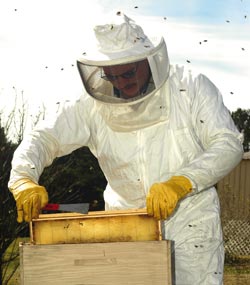Sweet Rewards – Alabama Beekeepers Enjoy Higher Prices

While many farmers are facing low prices for their commodities, honey producers are finding things sweeter than usual. In fact, prices are higher than anyone can remember, according to one of the state’s largest producers.Sandy Harrell of Lowndes County, along with his brothers Richard and David Harrell, are third-generation bee and honey farmers. Sandy said honey prices rose to $1.42 per pound last fall–that’s up almost a dollar a pound from the same time the year before when Alabama producers were getting about 48-cents a pound.”The biggest factor for the price increase has been the restriction of imports from China,” Harrell said. “The U.S. imports a lot of honey, most of it from China and Argentina. When U.S. inspectors found chemical contamination in some of the honey imported from China last year, that stopped all the imports from there for a while. Then, when imports did open back up, there were some pretty high tariffs in place.”While the outlook for honey prices appears bright, pests and other problems have caused colony numbers to drop in recent years, said Buddy Adamson, director of the Alabama Farmers Federation’s Bee and Honey Division. “It will take more than a couple of good years to make up for those losses,” he added.It’s the basic law of supply and demand. With less honey available in the U.S., prices went up. However, with this year’s honey flow just around the corner–it usually starts in April and goes through June–producers like the Harrells aren’t expecting prices to remain as high as last fall.With 3,000 colonies, the Harrells are one of the largest producers in Alabama. At one time, they had more than 8,000 colonies of bees scattered throughout the state.But while honey prices continued to fall or stay flat in the previous decade, there was an increase in expenses and a drastic increase in pests such as mites that damaged many colonies.”Bee keeping is a lot of work, and when the money’s not there, it’s hard to get up and go tend to them like you should,” Sandy said. “I can remember my dad selling honey for a nickel a pound. Back then we had colonies in several different counties. But as expenses began to increase, we’ve consolidated the locations.”Now, the Harrells have colonies in Dallas, Hale, Montgomery, Wilcox and Lowndes counties.The Alabama Department of Agriculture and Industries annual report on honey production shows Alabama honey producers, like others around the U.S., are getting paid more per pound for their honey, but the number of colonies has declined. The number of colonies has dropped from 14,000 in 2001 to 12,000 in 2002. During the same time, average honey prices went from 72 cent a pound to $1.11 per pound.Adamson said there are probably closer to 17,000 colonies in the state because many producers don’t report their production to state officials. The state also has hundreds of hobby producers, who keep all they produce, and medium-size operations, which have retail stores right on their farms–like Phillip and Nancy Garrison of Cullman County.Garrison, who serves on the Cullman County Farmers Federation Board of Directors, and is chairman of the county’s Bee and Honey Committee, said his market, unlike that of commercial producers, has been good for years.”Normally, we sell a quart for $3, and that weighs about 2.85 pounds,” Garrison said. “We won’t see such a big price increase, because we do all the bottling and labeling so we can charge more. Plus, people like the idea of buying pure honey produced right on the farm.”The Garrisons sell the bulk of their honey crop from their home in the Vinemont community near Cullman. In recent years, they expanded their market to include sales to grocery stores and a farm supply business, but because their honey was so popular, they couldn’t meet the demand. Last year, they produced about 1,800 pounds of honey from 30 colonies. The Garrisons also promote honey through programs at local schools.”There’s a whole generation of children who have never even tasted honey,” Garrison said. “They may have tried some their parents got at the grocery store, but that honey doesn’t taste the same. When we give them samples at school, they leave wanting more.”Garrison said the biggest difference in most commercial honey and that raised by a local producer is taste. Commercial honey contains honey from various locations–even honey that may have been produced outside the U.S.–and it’s all mixed together. Pure honey gathered by a local producer has a distinct taste because it isn’t mixed with other honey.Garrison’s advice: “Check the label and buy only pure honey, produced in the U.S. It’s superior in quality and taste.”
